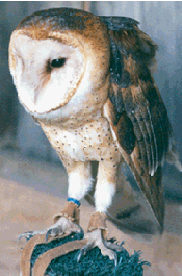|
Identification:
The barn owl (Tyto alba) is an immediately recognizable
bird, largely due to its oversized heart-shaped face, which has earned
it the nicknames "ghost owl" and "monkey-faced
owl". This owl is whitish on its underside, with a mixture of
golden and brown tones on the back. They are somewhat smaller than a
crow, with a length of 33-38 cm (13-15"). However, they have a
very large wingspan of 107-114 cm (42-45"). As with most raptors,
the male is significantly smaller than the female. A male averages 485
grams (17 ounces), whereas a typical female weighs around 570 grams
(20 ounces).
Occasionally barn owls (especially
young while in the nest) are detected by sound. Rather than an
owl-like hoot, they give a very harsh, rasping call.
Habitat:
Prior to human settlement, barn owls nested in tree cavities,
underground burrows, and occasionally nests abandoned by other birds.
Now, as their name implies, they are more commonly found nesting in
barns, as well as steeples, silos, and other buildings. Once they have
selected a particular nest site, barn owls tend to remain faithful to
it year after year.
|
|

June 1999: Gwen is a 4-year-old
human-imprinted barn owl residing at the Mountsberg Wildlife
Centre. (Photo by Mark Nash)
|
|
For hunting, barn owls require large areas
of grasslands, abandoned fields, or wetland edges. They search these areas
nightly for their favoured prey - meadow voles, mice, and shrews. Most
barn owls have a large territory; it is not uncommon for them to patrol an
area of 40 ha (100 acres).
Biology:
The barn owl has a voracious appetite - to raise a brood of six
owlets, a pair of adults will capture well over 1000 rodents. Itís
therefore fortunate that the barn owl is one of natureís most efficient
hunters. Like any other owl, it has a specialized first primary feather
which is serrated instead of smooth; this eliminates the wind vortex which
would otherwise form over the wing, and allows the owl to fly silently.
The barn owl is almost exclusively nocturnal, and can hunt perfectly well
in complete darkness thanks to its exceptional hearing. Its facial disks
function as parabolas to funnel sound to its ears. The ears are
asymmetrical, with the left one pointing down, and the right one opening
up. This unique arrangement allows them to accurately determine the
vertical position of a sound source by tilting their head up and down
until the volume is identical in both ears. In addition, they analyze the
difference in time between when the sound arrives at each ear, and use
this to pinpoint the horizontal location of the sound. Incredibly, they
can assess this time lag to within one one-hundred-thousandth of a second.
In flight, the owl continues to listen for the movements of its prey, and
adjusts its trajectory accordingly, giving it a high rate of success..
The barn owl does not build a nest as such,
but will often lay its eggs in a bed of its own pellets. Their average
clutch is five eggs, and these are typically laid in April, although
nesting can occur at any time of year. Young barn owls fledge after 8 to
10 weeks, after which time the female may sometimes lay a second clutch.
Conservation issues:
Like the peregrine falcon, the barn owl is found on every continent
except Antarctica, but is rare throughout most of its range. In North
America, it is native to most of the continental United States, as well as
southern British Columbia and southern Ontario.
Threats to the barn owl include exposure to
rodenticides and pesticides, as well as collisions with vehicles and power
lines. But the major cause of decline for this species is habitat loss.
Not only are the large grasslands they need for hunting disappearing, but
natural tree cavities have also become scarce, due both to the widespread
removal of dead trees by people, and the proliferation of other cavity
nesters such as squirrels and raccoons (which not only are competitors,
but also predators of young barn owls). As if that werenít enough, many
of the old barns suitable for nesting are being torn down in favour of
more modern (and impenetrable) buildings.
Nest boxes can be installed in suitable
habitat to provide barn owls with a home. Boxes should be placed out of
reach of predators, and with easy access for the owls. Any such effort
should be coordinated with an attempt to maintain or expand suitable
hunting habitat in the area.
Further reading: Canadian Wildlife (Summer 1999 issue),
The Birderís Handbook (Ehrlich, Dobkin, and Wheye, 1988) |
